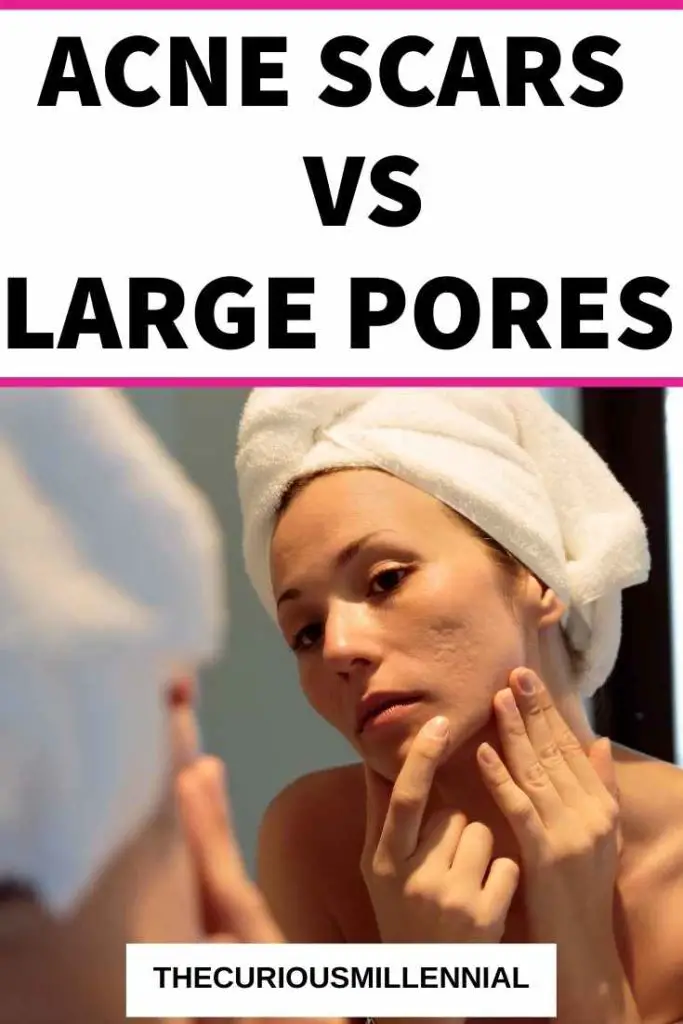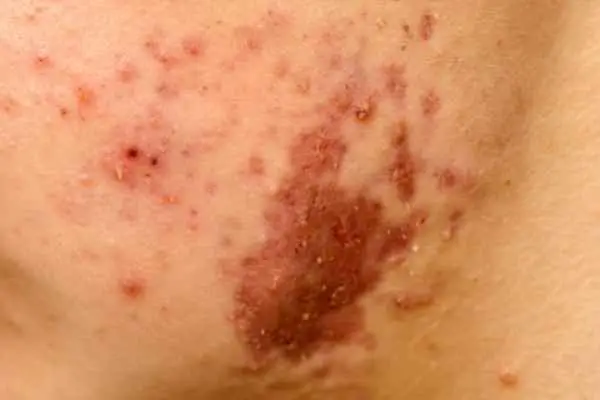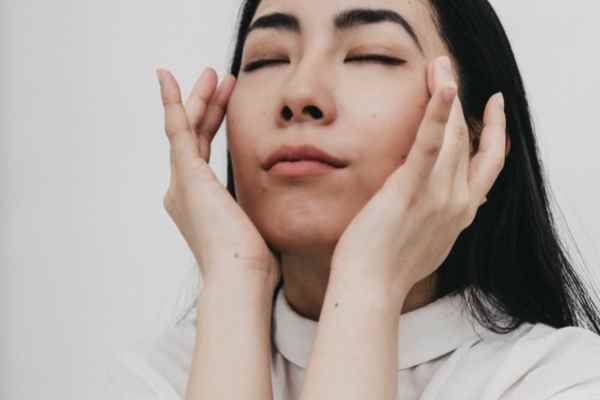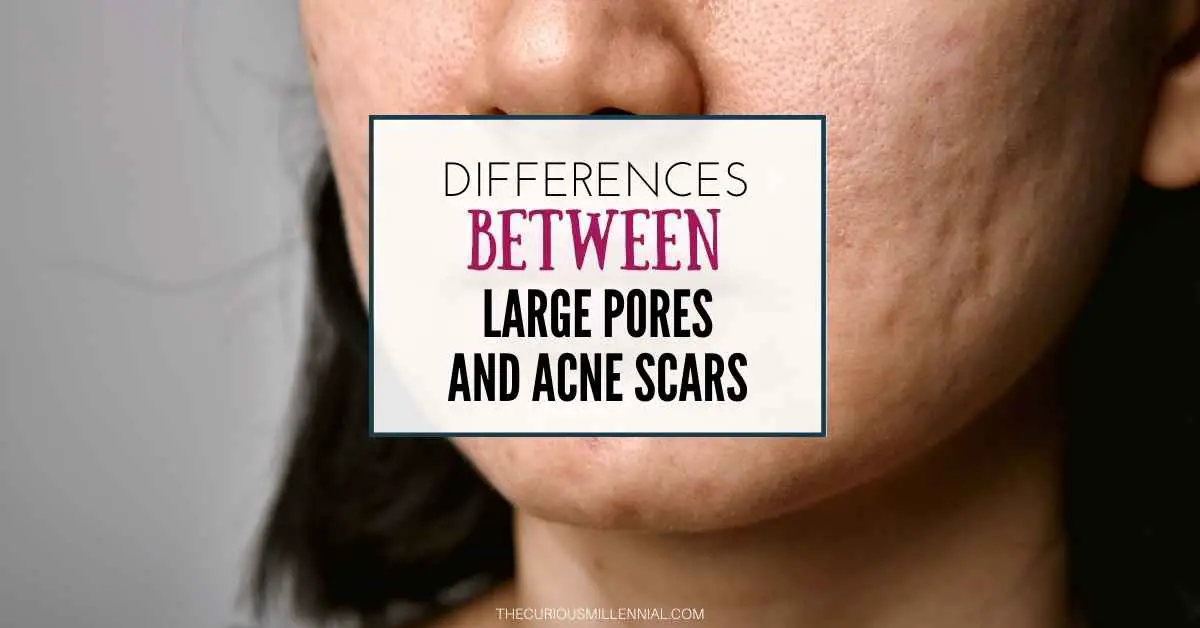Acne scars and large pores are two very different issues, but they often go hand in hand with each other. Acne scars will affect the appearance of your face because it leaves behind permanent damage from the breakout, while large pores make your complexion look oily and greasy.
In this article, we will explore the differences between acne scars and large pores in more detail.
Difference Between Large Pores And Acne Scars

- The main difference between large pores vs acne scars is that large pores can cause acne, while acne scars cannot cause large pores.
- Another difference between the two issues is their severity. Large pores are not always noticeable to the naked eye, but acne scars can be very severe and obvious.
- You can treat large pores using over the counter products and home remedies, but you will need to see a dermatologist to get rid of acne scars, and even that may not give positive outcome.
- Large pores do not cause permanent damage the way acne scars do, but they can make your complexion look worse. Acne scars, on the other hand, can make your face look sunken in and older.
- Acne scars is a chronic skin condition whereas large pores are not skin injuries.
- Finally, the causes of large pores and acne scars are different. Large pores are caused by genetics and environmental factors, while acne scars are caused by pimples and blackheads.
What are Acne Scars?
Acne scars are marks that are left behind on the skin after a breakout has occurred. They can be either raised or depressed, and they can vary in size and shape. The majority of acne scars are the result of inflamed blemishes known as papules and pustules.
These blemishes often cause significant damage to the surrounding tissue, which then leaves behind a scar once it has healed.
What Causes Acne Scars?
There is no one definitive answer to this question, as there are several factors that can contribute to the formation of acne scars. Some of the most common causes include:
• Picking or popping pimples
• Having a severe case of acne
• Having a genetic predisposition to developing scars
Types Of Acne Scars

There are four main types of acne scars:
1. Atrophic scars
2. Hypertrophic scars
3. Keloid scars
4. Boxcar scars
Atrophic Scars
Atrophic scars are the most common type of scar, and they typically appear as small depressions in the skin. These scars are caused by a loss of collagen and elastin, which are two proteins that help to keep the skin firm and plump.
Hypertrophic Scars
Hypertrophic scars are raised and thickened scars that occur when there is an overproduction of collagen in the healing process. These scars can be itchy and uncomfortable, and they often grow larger than the original blemish.
Keloid Scars
Keloid scars are the result of an excessive amount of collagen being produced during the healing process. These scars are raised and can be very large, and they often extend beyond the original boundary of the blemish.
Boxcar Scars
Boxcar scars are acne scars that have a defined edge and a square shape. They are typically caused by ice pick acne lesions, which are very deep and penetrate far into the skin.
What Are The Symptoms Of Acne Scars?
The symptoms of acne scars can vary depending on their type. However, some of the most common symptoms include:
• Visible scarring
• Redness
• Swelling
• Pain
How To Prevent Acne Scars
There are several things that you can do to try and prevent acne scars from forming. Some of the most effective prevention methods include:
• Washing your face twice a day with a gentle cleanser
• Avoiding picking or popping pimples
• Using an over-the-counter topical retinoid
• Seeing a dermatologist for help managing severe acne
How Can Acne Scars Be Treated?
There are a variety of different treatments that can be used to improve the appearance of acne scars. Some of the most popular options include:
Laser Resurfacing
This treatment uses a concentrated beam of light to remove the top layer of skin, which helps to lessen the appearance of scars.
Dermal Fillers
Dermal fillers are injectable treatments that can help to plump up depressed acne scars. This treatment can also be used to help smooth out raised scars.
Microneedling
Microneedling is a treatment that uses tiny needles to create microscopic holes in the skin. This stimulates the production of collagen, which can help to improve the appearance of scars.
Chemical Peels
Chemical peels use a solution to remove the top layer of skin, which can help to improve the appearance of scars.
Dermabrasion
Dermabrasion is a treatment that uses a rotating brush to sand down the top layer of skin. This can help to improve the appearance of scars.
Acne scars can be a source of insecurity and low self-esteem for many people. If you are struggling with acne scars, know that you are not alone. There are a variety of treatments that can help to improve their appearance. Talk to your dermatologist about which treatment option may be right for you.
What are Large Pores?
Pores are natural anatomical features of the skin that are designed to secrete sebum, sweat, or tracks for hair follicles. These structures might become big enough to be seen and undesirable at times. They may also get clogged and cause a secondary issue like folliculitis or acne as a result.
Large pores don’t always lead to acne. However, since the two are linked, controlling one may assist with the control of the other. There is a higher chance of developing acne scarring when there is constant skin contact with acne.
Acne scars do not have to appear in everyone who has acne. Scarring is usually passed down via genetics and related to an individual’s unique inflammatory response.
What Causes Large Pores?
There are a number of different factors that can contribute to the development of enlarged pores, including:
- Age – The older you get, the more likely you are to develop enlarged pores.
- Genetics – Some people are simply born with larger pores than others.
- Hormones – Changes in hormone levels can cause the pores to become enlarged.
- Sun exposure – UV radiation can damage the skin and cause the pores to enlarge.
- Oily Skin – Pores that are large in size may look even larger on an oily complexion.
Symptoms Of Large Pores
The most common symptom of large pores is their appearance on the skin. They can be seen as small, dark spots on the skin. Other symptoms include:
• Blackheads
• Whiteheads
• Acne
How To Prevent Large Pores
Some of the most common tips for preventing large pores include:
• Keep your skin clean and free of oil and dead skin cells
• Use a gentle facial cleanser
• Avoid using harsh scrubs on your skin
• Use a moisturizer that is suited for your skin type
• Apply sunscreen every day
How Can Large Pores Be Treated?

There is no one definitive answer to this question, as there are a variety of different treatments that can be used to improve the appearance of enlarged pores. Some of the most popular options include:
Laser Therapy
This treatment uses a concentrated beam of light to heat the tissue and cause the pores to contract.
Microdermabrasion
This treatment uses a rotating brush to remove the top layer of skin, which can help to improve the appearance of enlarged pores.
Chemical Peel
A chemical peel uses a solution to remove the top layer of skin, which can help to improve the appearance of enlarged pores.
Home Remedies
There are a number of different home remedies that can help to improve the appearance of enlarged pores. Some of the most popular options include:
• Washing your face with warm water and a gentle cleanser
• Using a facial mask made with egg whites
• Applying a cucumber slice or lemon juice to the skin
• Rubbing baking soda on the skin
When To See A Doctor
Most people with enlarged pores do not need to see a doctor, as they can be treated at home.
However, if you are concerned about the appearance of your pores, or if home treatment methods are not working, you may want to see a dermatologist for further evaluation and treatment.
Acne Scars Vs Large Pores – Final Verdict
At the end of the day, it is important to remember that both acne scars and large pores are completely normal! Everyone has them, and there is no need to feel self-conscious or embarrassed about them.
However, if you unhappy with their appearance, there are a number of different treatments available that can help to improve their appearance. Speak to your dermatologist to find out which treatment is right for you.

